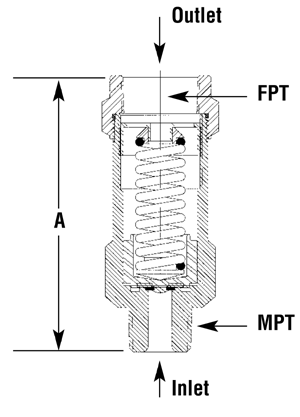
For relief valves, the minimum setting should be at least 25% above the maximum system operating pressure (MSOP). Here is an example:
MSOP = 280 psi
Minimum relief valve setting =
1.25 x 280 = 350 psi
The maximum allowable setting should be equal to the design working pressure of the vessel.
These safety factors will provide sufficient spring force on the valve seat to maintain a tight seal and still allow for setting tolerances and other factors that cause settings to vary.
A refrigerant safety valve is designed to prevent pressure in a vessel from rising above a safe level when operating controls fail or when the vessel is exposed to excessive heat.
With a properly sized relief valve installed on the vessel, the refrigerant is released at a controlled rate so that a safe pressure is maintained in the vessel. If sized correctly, the relief valve has enough discharge capacity to prevent the pressure in the vessel from rising more than 10% above its design working pressure.
Experience has shown that although relief valves are originally set to within a few pounds of the stamped setting, the variation may be as much as 10% of the stamped setting after the valves have been stored or placed in service for prolonged periods of time.
If vessel pressure increases within 10% of set pressure of the relief valve, the valve may begin to “seep.” With increasing pressure, gas flow will increase to the “pop” point when the valve goes full open, providing full discharge.
By code, the valves must be full open within 10% of the valve’s stamped setting. However, under certain system conditions, it is possible a valve could start to relief, but not open fully. Under these conditions, valves would either continue to seep or “chatter.”
Relief valves are designed to reclose as the pressure is reduced. However, it is generally due to an accumulation of dirt and foreign matter that impinges on the valve seat disc, while the valve is discharging.
For this reason, it is almost impossible to predict, with any degree of certainty, the reliability of the relief valves resealing after they have discharged in service. This condition also allows the relief valve to seep refrigerant after reclosing, but not necessarily reseal.
Although relief valves are designed to reclose after discharging, this feature is intended only to minimize the loss of refrigerant until the valve can be replaced.
Service complaints concerning the loss of refrigerant are greatest with refrigerants having high saturation pressures, such as R-22 and -404A. Complaints are noted particularly in the summertime with very high ambient temperatures.
Problems may arise with the valve subjected to high ambient temperatures, which might be encountered in an equipment room or on a rooftop. Failure to take advantage of the maximum allowable relief valve setting may contribute to relief valves seeping.
And, when sizing relief valves, failure to consider such factors as outlined in this article can lead to valves that are set at too low a pressure. The result can be valves that seep in extremely hot weather, with the possibility they will continue to seep after reclosing.
Piasecki is with Henry Technologies. For more information, call 800-323-4052 or visit www.henrytech.com (website).
Publication date: 04/01/2002

Report Abusive Comment